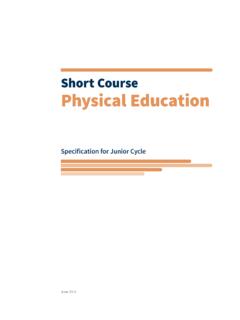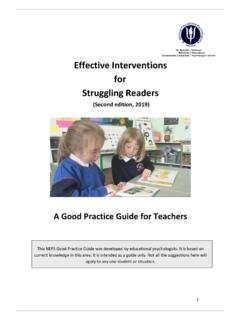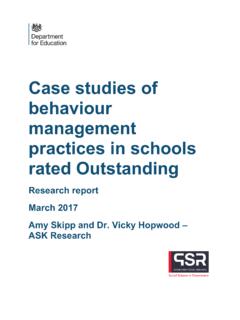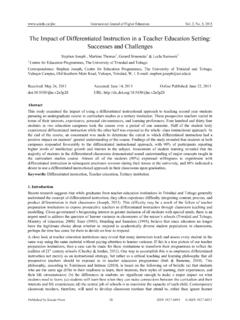Transcription of Bold beginnings - The Reception curriculum in a sample of ...
1 bold beginnings : The Reception curriculum in a sample of good and outstanding primary schools2 bold beginnings : ToheRbec pturm Toa urttfyIn January 2017, Her Majesty s Chief Inspector (HMCI) commissioned an Ofsted-wide review of the curriculum . Its aim was to provide fresh insight into leaders curriculum intentions, how these are implemented and the impact on outcomes for pupils. This report shines a spotlight on the Reception Year and the extent to which a school s curriculum for four- and five-year-olds prepares them for the rest of their education and obegdins:TExecutive summary 4 Key findings 5 Recommendations 7 Reception a unique and important year 8 The curriculum 12 Teaching 16 Language and literacy 19 Mathematics 24 Assessment and the early years foundation stage profile 26 Initial teacher education 29 Methodology 31 Annex A: Schools visited 32 Annex B: Online questionnaire 34 Contents4 bold beginnings : ToheRbec pturm Toa urttfyExecutive summaryA good early education is the foundation for later success.
2 For too many children, however, their Reception Year is a missed opportunity that can leave them exposed to all the painful and unnecessary consequences of falling behind their peers. During the summer term 2017, Her Majesty s Inspectors (HMI) visited successful primary schools in which children, including those from disadvantaged backgrounds1, achieved well. This report examines the provision in their Reception Year and the extent to which it was preparing four- and five-year-olds for their years of schooling and life was at the heart of the curriculum in the most successful classes. Listening to stories, poems and rhymes fed children s imagination, enhanced their vocabulary and developed their comprehension. Systematic synthetic phonics played a critical role in teaching children the alphabetic code and, since this knowledge is also essential for spelling, good phonics teaching supported children s early teaching of early mathematics was not given the same priority.
3 However, it was clear what children could achieve. The schools that ensured good progression frequently used practical equipment to support children s grasp of numbers and, importantly, to develop their understanding of linking concrete experience with visual and symbolic representations. More formal, written recording was introduced, but only when understanding at each stage was secure and automatic. The schools visited understood that teaching had different purposes. Play, for example, was used primarily for developing children s personal, social and emotional skills. They learned to investigate the world around them, both physically and imaginatively. However, around two thirds of the staff inspectors spoke to confused what they were teaching (the curriculum ) with how they thought they were 1 In the context of national outcomes at the age of five, as reported through the early years foundation stage profile (EYFSP), disadvantaged children refers to those who are known to be eligible for free school Early years (under-5s) foundation stage framework (EYFS) , Department for Education, March 2014; Early years foundation stage profile: handbook 2017 , Department for Education, October 2014; to teach it.
4 This seemed to stem from misinterpreting what the characteristics of effective learning in the early years foundation stage (EYFS)2 playing and exploring, active learning, and creating and thinking critically required in terms of the curriculum they provided. The EYFS profile (EYFSP)3 is a mechanism for statutory summative assessment at the end of the foundation stage. However, in nearly every school visited, the staff felt that the EYFSP was burdensome. Many teachers devised tasks simply to tick off elements of the early learning goals so that they could provide evidence of children s achievement. By default, these tasks and ticking them off became the Reception curriculum , with a significant loss of focus on learning, step by and Year 1 teachers agreed that the vital, smooth transition from the foundation stage to Year 1 was difficult because the early learning goals were not aligned with the now-increased expectations of the national curriculum .
5 Progression and continuity in mathematics were seen as particularly strongest performing schools, however, had found ways to improve their assessment processes and support transition. Checks of children s phonics knowledge, standardised tests (for reading, for example) and scrutinies of children s work provided the essential information that Year 1 teachers needed. Such information was quick to collect and more useful for them. These successful schools made sure that they gave reading, writing and mathematics in their Reception classes sufficient direct teaching time every day, with frequent opportunities for children to practise and consolidate their growing knowledge. The headteachers made sure that their curriculum was fit for purpose, so that children were equipped to meet the challenges of Year 1 and obegdins:TKey findings The headteachers recognised that a successful Reception Year was fundamental to their school s success. They were clear that children s achievements up to the age of five can determine their life chances.
6 They did not accept the view that some will catch up later . In the schools visited, leaders and staff had significantly increased their expectations for how reading, writing and mathematics are taught since the implementation of the 2014 national curriculum . Many headteachers expressed considerable concern that simply to meet the early learning goals (ELGs) was insufficient preparation for children s learning in Year 1 and beyond. They therefore designed their Reception curriculum to give children the necessary foundations for the rest of their schooling. These schools were clear that Reception children need more than a repeat of their pre-school experiences in Nursery or earlier. There is no clear curriculum in Reception . Most leaders and staff in the schools visited acknowledged that there was little guidance about what four- and five-year-olds should be taught, beyond the content of the ELGs. They therefore determined their own curriculum , above and beyond the statements in the EYFSP, to prevent staff using the ELGs as their sole framework for teaching.
7 Many of the schools visited found the processes of the EYFSP burdensome. Headteachers were keen to reduce teachers workload by recognising that, although some assessments were best made from observations, others were not. The headteachers prioritised language and literacy as the cornerstones of learning. They ensured that sufficient time was given to developing children s spoken language and teaching them to read and write. Reading was at the heart of the curriculum . Children read out loud frequently from carefully selected books that closely matched their phonic knowledge. Story time was a valued part of the daily routine. Staff recognised it as essential in developing children s language, vocabulary and comprehension. In schools visited where writing was of a high standard, the children were able to write simple sentences and more by the end of Reception . They were mastering the spelling of phonically regular words and common exception words.
8 These schools paid good attention to children s posture and pencil grip when children were writing. They used pencils and exercise books, while children sat at tables, to support good, controlled letter formation. Most of the schools had designed their own mathematics curriculum , based on the Year 1 national curriculum programme of study. This provided a strong basis for more complex learning later. However, leaders were much clearer about their expectations for children s literacy than for mathematics. All the schools visited planned a judicious balance of direct whole-class teaching, small-group teaching, partner work and play. They were clear about and valued the contribution to children s learning from each. Play was an important part of the curriculum in all of the schools visited. The headteachers knew which aspects of learning needed to be taught directly and which could be learned through play. However, except for literacy and mathematics, the schools were not clear about the time they devoted in a typical week to the different areas of beginnings : ToheRbec pturm Toa urttfyKey findings continued Headteachers took the continuing professional development (CPD) of staff seriously.
9 Many of the schools that were using a specific reading and/or writing programme bought in regular training to ensure that all staff taught the programme effectively. Leaders said this provided important induction, particularly for staff who were new to the school. Most leaders felt that newly qualified teachers (NQTs) were not well prepared to teach mathematics, reading and writing in Reception . They often had little experience of teaching Reception during their initial teacher obegdins:TRecommendationsAll primary schools should: make sure that the teaching of reading, including systematic synthetic phonics, is the core purpose of the Reception Year attach greater importance to the teaching of numbers in building children s fluency in counting, recognising small numbers of items, comparing numbers and solving problems ensure that when children are learning to write, resources are suitable for their stage of development and that they are taught correct pencil grip and how to sit correctly at a table devote sufficient time each day to the direct teaching of reading, writing and mathematics, including frequent opportunities for children to practise and consolidate their skills use the EYFSP as a guide to end-of- Reception expectations rather than to define what should be teacher education providers should.
10 Make sure that all primary trainees have sufficient knowledge of Reception , so that they understand progression from the early years foundation stage onwards devote a greater proportion of their training programme to the teaching of reading, including systematic synthetic phonics as the route to decoding words, and the composition of numbers, so that all newly qualified teachers are competent and confident to teach early literacy and Education Act 2005, section 8; Department for Education should: review the scope and breadth of the statutory EYFS framework to ensure that schools better understand the nature and purpose of the Reception Year and what should be taught review the content of the EYFSP so that there is greater alignment between the ELGs at the end of the Reception Year and the national curriculum for Year 1 streamline the EYFSP and associated moderation processes so that they reduce teachers workload around assessment and become more useful for benchmarking the knowledge and understanding children need for the rest of their formal education raise the profile of early mathematics teaching, similar to the investment made in early reading and the teaching of systematic synthetic phonics, by supporting the development of appropriate schemes and should.















